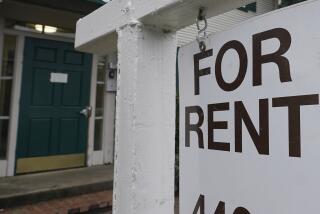Landlord Defections From Aid Plan Feared
- Share via
With the need for subsidized housing growing, and waiting lists for assistance longer than they have been in years, officials in the Southland and Washington are bracing for an epidemic of defections by landlords from a federal rent assistance program.
In Los Angeles, 6,000 apartments are expected to be removed from the rolls over the next six years, as owners exercise a little-known right to abandon the so-called project-based Section 8 subsidy program as their contracts with local and federal officials expire.
Nationwide, about 30,000 units are expected to be withdrawn from Section 8 in fiscal 1998, according to figures provided by the U.S. Department of Housing and Urban Development, with more in years to come.
“It really means a loss of the stable housing stock,” said Don Smith, director of the city of Los Angeles Housing Authority. Over the last few months, he said, as many as 200 apartments have been withdrawn from the program in the city, and owners of 836 more are expected to drop out by next spring.
Under Section 8, which was set up in the 1960s and got its colloquial name from being the eighth part of the Housing and Urban Development code, builders were provided insurance and subsidies in exchange for renting to low-income tenants.
The problem of owners dropping out has been brewing for several years as Congress has chipped away at some of the perks that were meant to lure them in.
Landlord participation is expected to plunge between now and 2004, as 20-year contracts signed in the mid-1970s to the mid-1980s begin to expire.
“The impact will be devastating,” said tenants rights advocate Larry Gross, executive director of the Coalition for Economic Survival. “We already have a housing crisis. And if you take away the [Section 8] subsidy, there are going to be a lot more people on the street.”
The number of properties whose owners will have the opportunity to quit the program in the next two years is staggering. Contracts are coming up for renewal for 9,000 projects containing 684,000 apartments. In the Los Angeles metropolitan area, 300 projects with 24,000 units have contracts that are expiring in that period.
Many of the owners of these projects will probably stay in the program. But already in Southern California, owners of 58 properties, with 3,750 apartments, have signaled an interest in dropping out.
At HUD, officials are downplaying the impact, saying tenants will still be covered under so-called portable Section 8 vouchers, which they can use anywhere a landlord will accept them.
But housing advocates and authorities in Los Angeles say the vouchers provide tenants with little security because Congress must renew them every year, and not all landlords accept them. Plus, according to Smith of the city Housing Authority, HUD has recently reduced the subsidy that it will pay on the vouchers about 14%, so tenants will have to move to cheaper neighborhoods in order to use them.
Encino developer John MacLaurin decided last summer to pay off the HUD-insured mortgage he held on a beachfront building in Venice that had been devoted to low-income senior citizens.
By doing so, he was no longer required to participate in the project-based Section 8 program, in which landlords receive subsidies in exchange for renting to low-income tenants. Under the terms of the program, MacLaurin’s elderly tenants only had to pay 30% of their income as rent.
He said he was being driven out of the program because of increased red tape and reduced remuneration.
“The reason I participated in these programs originally was to bring something better to the quality of life of the people that I rented to,” said MacLaurin, who serves on the California Commission on Aging. “And I can’t do that anymore. So I am disappointed. I could have found a lot of other ways to make money and not have the heartache. If they left things the way they were, I would continue.”
As promised by HUD, MacLaurin’s tenants received the portable Section 8 certificates to cover the new, market-level rents that he was now charging, about $700 a month.
But Thursday, MacLaurin and his tenants were told that the certificates would be worth $200 less per month next year.
And that means the residents will have to move.
“This is terrible,” said Carol Berman, who is disabled and has lived in MacLaurin’s building for 10 years, paying about $160 a month for her rent. “I get very frightened when I think about it. . . . I wish I were a drunk so I didn’t have to deal with it.”
There are three basic ways in which a property owner can remove a building from the project-based Section 8 housing rolls.
Some, their 20-year contracts up, no longer want to deal with the increasing red tape and the uncertainty of shrinking housing appropriations, and decide not to renew.
Others, who have federally insured loans that require them to participate, may exercise an option after 20 years to pay off the mortgage. This removes them from any obligations to participate in Section 8.
Finally--and HUD estimates that as many as 500,000 apartments nationwide may be in this category--there are the property owners whose monthly subsidies have been reduced by the U.S. government.
These landlords, federal officials say, are receiving too much money per month, thanks to ‘70s-era deals that promised to help them pay for high-interest mortgages and skyrocketing land prices.
HUD has agreed to help pay down these mortgages so the new, reduced subsidies will still cover a property owner’s monthly bill. But the Internal Revenue Service recently said it might force the property owners to pay taxes on the amount the loan has been reduced.
So, many landlords, like MacLaurin, are simply paying off their mortgages and extricating themselves from the program.
“People are living comfortably in a location that is very desirable and not paying much rent, and they will be asked to leave,” said MacLaurin, who blames HUD for changing the rules and creating instability. “They will be torn up from the place that they are used to.”
Paul Leonard, HUD deputy assistant secretary, said the department will be able to avoid a big wave of defections by working with property owners on taxes and other issues.
“There is a possibility that there will be some sort of massive loss, but the reality is that most folks are staying in,” he said. “There isn’t this huge reduction in project-based inventory occurring.”
Leonard said significantly fewer landlords quit the program last year than HUD expected.
Moreover, he said, tenants whose buildings are no longer covered under the program will still be eligible for assistance under funding that Congress approved last week.
“There is no overall reduction in the number of families that will be receiving assistance,” Leonard said.
That may be true, but it still means that the housing stock devoted to low-income residents will be reduced, particularly in nicer neighborhoods, said Sally Richman, director of planning for the L.A. Housing Department.
Plus, the value of the vouchers has been reduced and just covers rents that are 40% of the median in the Los Angeles and Long Beach areas.
To make matters worse, a HUD program designed to help tenants and nonprofit organizations buy properties whose owners were prepaying their mortgages and opting out of Section 8 was gutted in the last budget agreement.
In the end, housing advocates fear, tenants will relocate, perhaps to rougher areas and perhaps repeatedly.
“Will they have to move? Some will,” Leonard said. “Will they move to better or worse conditions? That really depends on the city and the housing conditions that they’re in.”
Last summer, the owner of the Lurline Apartments in Chatsworth prepaid the mortgage, removing the building from project-based Section 8 while continuing to accept vouchers.
Jesus and Maria Camarena, who live there with their two children, were told that their combined income of $32,000 was too high to qualify for the portable Section 8 vouchers.
The rent on their three-bedroom apartment nearly doubled, from $424 a month to $830, and the increased payment is due--along with a late charge.
“I think we have to leave because I don’t have the money,” Maria Camarena said. “We used to live very well here. We lived here for eight years.”
And it’s not just property owners in federal programs such as Section 8 who are opting out. Just last week, elderly residents of the Promenade Apartments in Burbank were forced to leave after the owner decided not to renew a contract with state authorities to provide low-income housing.
“That’s exactly the kind of thing that thousands of people will face,” Richman said. “There will be a lot of sob stories.”
Michael Bodoken, a housing aide to former Mayor Tom Bradley and director of the National Housing Trust, said that 20,000 apartments have been lost nationwide as owners have prepaid their mortgages and removed the property from Section 8 rolls.
It’s misleading, he said, to assert that portable vouchers will cover that loss.
Unless housing is made permanently affordable, Richman said, it will be forever at the whim of the marketplace or of Congress, which might yank funding at any time. If a neighborhood gentrified, the units would probably not be available--or affordable--to tenants with vouchers. If a new owner came in with a big mortgage, these limited subsidies might not provide enough income to cover the loan.
“It’s like term life insurance,” she said. “You stop paying and it’s gone. You’re not building an asset.”
(BEGIN TEXT OF INFOBOX / INFOGRAPHIC San Fernando Valley edition
At a Glance
Tens of thousands of low-income renters across the country could be forced to move from their apartments over the next several years as landlord’s contracts with government subsidy programs are retooled or allowed to expire.
The number of contracts up for renewal nationwide between now and 2000 is 9,000, representing 684,000 apartments.
In Southern California, contracts are ending for 300 housing complexes representing 24,000 apartments.
More to Read
Sign up for Essential California
The most important California stories and recommendations in your inbox every morning.
You may occasionally receive promotional content from the Los Angeles Times.






